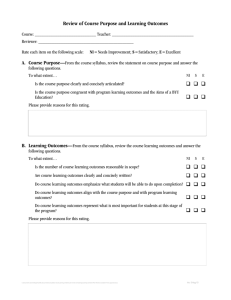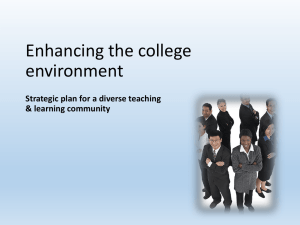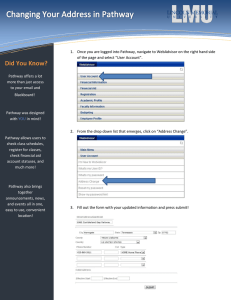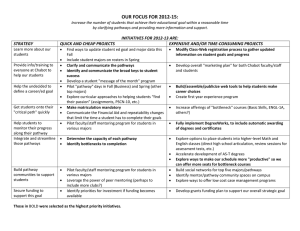strategies. POTENTIAL TITLE III FOCUS STRATEGIC PLAN UMBRELLA:
advertisement
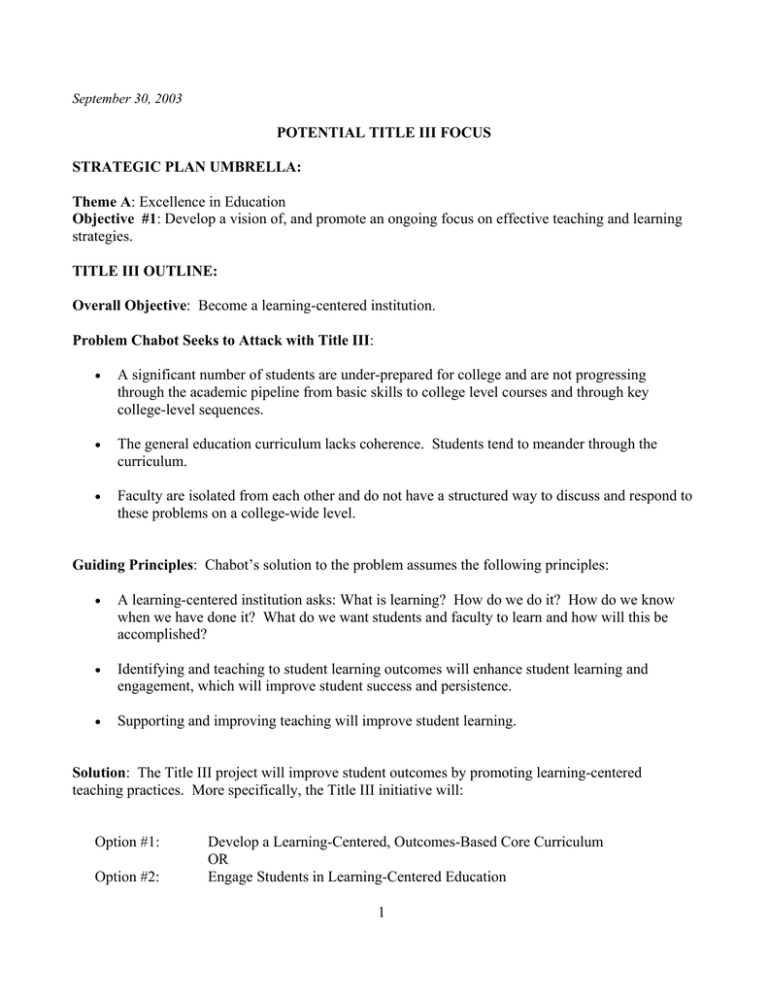
September 30, 2003 POTENTIAL TITLE III FOCUS STRATEGIC PLAN UMBRELLA: Theme A: Excellence in Education Objective #1: Develop a vision of, and promote an ongoing focus on effective teaching and learning strategies. TITLE III OUTLINE: Overall Objective: Become a learning-centered institution. Problem Chabot Seeks to Attack with Title III: • A significant number of students are under-prepared for college and are not progressing through the academic pipeline from basic skills to college level courses and through key college-level sequences. • The general education curriculum lacks coherence. Students tend to meander through the curriculum. • Faculty are isolated from each other and do not have a structured way to discuss and respond to these problems on a college-wide level. Guiding Principles: Chabot’s solution to the problem assumes the following principles: • A learning-centered institution asks: What is learning? How do we do it? How do we know when we have done it? What do we want students and faculty to learn and how will this be accomplished? • Identifying and teaching to student learning outcomes will enhance student learning and engagement, which will improve student success and persistence. • Supporting and improving teaching will improve student learning. Solution: The Title III project will improve student outcomes by promoting learning-centered teaching practices. More specifically, the Title III initiative will: Option #1: Option #2: Develop a Learning-Centered, Outcomes-Based Core Curriculum OR Engage Students in Learning-Centered Education 1 September 30, 2003 Title III Option #1: Develop A Learning-Centered, Outcomes-Based Core Curriculum. 1. Engage faculty in college-wide discussions to collectively define what students should know and be able to do upon completion of general education requirements. Use the teaching goals inventory (TGI) to define course and discipline learning goals and to inform discussion and development of general education learning outcomes or core competencies. 2. Implement a multi-year strategy to incorporate learning outcomes throughout curriculum, teaching, and assessment practices. Focus on key G.E. academic pathways. a. Align learning outcomes/core competencies with classroom assessment techniques (CAT) and teaching methodologies. Support and train faculty through professional development and release time for curricular design. b. Develop strategies to capture student mastery of learning outcomes such as capstone courses or student portfolios (could focus on one method). Support through professional development and release time. c. Pilot CAT, teaching methodologies, capstone courses, and/or student portfolios in key academic pathways. d. Evaluate impact of pilot on student learning according to defined general education learning outcome/core competencies. e. Implement educational case management systems to ensure student progression through key G.E. pathways. f. Implement learning support systems such as supplemental instruction to ensure student mastery of core competencies. 2 September 30, 2003 Table 1: Core Curriculum Title III Model DEVELOP A LEARNING-CENTERED AND OUTCOMES-BASED CORE CURRICULUM Teaching Goals and Student Learning Outcomes Goals at Course and Discipline Level Campus-Wide Focus Groups on G.E. Learning. Outcomes Faculty Development and Curricular Design Pathway #1 YEAR 1 YEAR 2 YEAR 3 YEAR 4 YEAR 5 ∗ ∗ ∗ ∗ ∗ ∗ ∗ ∗ ∗ ∗ Pathway #2 ∗ ∗ ∗ ∗ Pathway #3 Pilot Capstone/Student Portfolios Pathway #1 ∗ Pathway #2 ∗ ∗ Pathway #3 Learning Support Systems ∗ Pathway #2 Pathway #3 Pilot CAT and Teaching Methodologies Pathway #1 = in progress ∗ = fully implemented 3 September 30, 2003 Title III Option #2: Engage Students in Learning Centered Education 1. A. Develop and implement a [series of?] first-year experience learning cohorts OR B. Develop and implement learning cohorts in high attrition areas/key academic pathways OR C. Link A or B with access to technology enhanced learning environments. • All of the above options would involve faculty participation in learning community professional development. Faculty training could emphasize use of classroom assessment techniques, valuing diversity and embedding multicultural issues in the curriculum, study skills/student success strategies, discipline-specific reading strategies, and applying learning theory (multiple intelligences) in the curriculum. • Could involve experienced learning community faculty as mentors or faculty development facilitators. Possibly add: 2. Elements of Option #1 such as incorporating student portfolios or student support systems such as educational case management or supplemental instruction. 4 September 30, 2003 LIST OF POTENTIAL ACTIVITIES FROM INPUT SESSONS Title III Option #1: Develop A Learning-Centered, Outcomes-Based Core Curriculum. • • • • • • • • • • • Implement teaching goals inventory (TGI) at course, discipline, and college level. Develop and pilot measures of learning outcomes at course, discipline, and college level. Develop, pilot, implement, and institutionalize classroom assessment techniques (CAT). Implement supplemental instruction, such as tutoring, study groups, etc. Design and implement curricula that evaluates achievement of learning outcomes such as capstone courses or modifications to gateway courses. Implement faculty mentoring/faculty development models. Encourage and train other faculty in TGI and CAT. Develop and implement discipline-specific reading strategies across the curriculum. Develop a new play that contributes to a discussion of learning and teaching in our diverse community. Develop and implement faculty training that addresses 1) multicultural issues 2) the nature of intelligence (multiple intelligence, social/emotional intelligence) and how learning happens. Integrate study skills/student success strategies into classroom teaching. Establish an institutional framework for addressing study skills so that faculty can reinforce the message across disciplines. Title III Option #2: Engage Students in Learning Centered Education • • • • • • • • Create interdisciplinary student learning communities across the institution (i.e. entering/early decision students, nursing students, other). Implement supplemental instruction, such as tutoring, study groups, etc Implement faculty mentoring/faculty development models. Develop and implement discipline-specific reading strategies across the curriculum. Create opportunities for faculty to observe teaching across disciplines. Expand and diversify classroom methodologies that use technological resources, encouraging innovative teaching strategies. Develop and implement faculty training that addresses 1) multicultural issues 2) the nature of intelligence (multiple intelligence, social/emotional intelligence) and how learning happens. Expand access to and use of technology in the classroom, particularly among part-time faculty. Other Activity Suggestions • • • • Improve usefulness of placement testing. Provide release time for faculty to take classes outside their disciplines. Provide technical support at the division level so that instructors have access to in-house expertise in their classrooms when issues arise. Re-institute instructional skills workshops for faculty and expand across the curriculum, particularly within key academic pathways. 5

